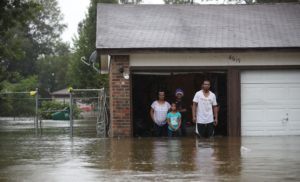
Floods in the United States pose a unique regulatory challenge.
Between 1996 and 2019, a flooding event affected 99 percent of U.S. counties. Nonetheless, insurance companies have severely limited flood insurance coverage absent government incentives since 1927.
The National Flood Insurance Program (NFIP) arose out of a public need for flood insurance coverage. The Great Mississippi Flood of 1927, which submerged 23,000 square miles of land and displaced hundreds of thousands of people in the lower Mississippi River valley, resulted in private insurers cutting back on their flood coverage. The National Flood Insurance Act of 1968 established the NFIP to promote state and local governments reducing development on land exposed to flood risks, and establish a “cooperative public-private program” providing flood insurance to the American market.
Despite the NFIP continuing to provide coverage today, flood coverage in the United States leaves much to be desired. Despite the heavy damage that flooding can cause, only 11 percent of American homeowners possess flood coverage. Even in two major metropolitan areas prone to flooding, Houston and Miami, only 36 percent and 34 percent of homeowners, respectively, secured this protection. These low coverage rates alongside the number of NFIP policies in force decreasing over the past decade, and the program possessing more than $20 billion in debt.
Local flood insurance issues have also drawn public criticism. For instance, the Federal Emergency Management Agency (FEMA) redrew flood maps of New Orleans, Louisiana which establish where homeowners are required to purchase flood policies. The changes drew criticism when the agency moved “more than half the population” out of the “high-risk zone” which mandates the purchase of flood insurance. The map adjustments occurred despite the city sitting “roughly 50 percent” below sea level and “experiencing one of the highest rates of sea level rise in the world.”
This seminar highlights scholarship on how flood management could adapt to new waves of regulation, as well as the changing environmental landscape.
- In a project which aims to uncover the common characteristics of Texas communities not participating in the NFIP, Morgan White identifies the top 20 municipalities and top five counties which could benefit from the program. White considers factors including flood susceptibility, urban and rural classification, history of participation in the program, and FEMA floodplain map status in the hope that her results could guide NFIP outreach efforts in the state.
- In a recent Journal of Economic Perspectives article, Erwann O. Michel-Kerjan argues that addressing several key challenges could improve the NFIP. One challenge, Michel-Kerjan explains, is “improving the accuracy of the flood risk maps.” Overcoming this challenge may “require a national initiative with special appropriation by the U.S. Congress to go well beyond what the Federal Emergency Management Agency has been able to do so far given its current budget,” he asserts. Michel-Kerjan argues that another challenge is to “encourage investment in risk reduction measures.” He suggests that “the development of a multiyear flood insurance” could help and that banks or the federal government could roll this out by “offering home improvement loans to flood insurance policyholders for mitigation activities.” Michel-Kerjan concludes by describing the ways that other countries respond to “the problem of flood insurance” and points out that homeowners’ policies from private insurers in the United Kingdom usually, and policies from private insurers in France always, include flood coverage.
- As severe flooding events continue to draw attention in America, some scholars advocate for a greater role for the private sector in flood insurance provision. In a 2019 article for the Review of Business: Interdisciplinary Journal on Risk and Society, economists Patricia Born and Robert Klein propose a “‘hybrid’ privatization of the NFIP involving legislative and regulatory measures that would make it easier for private companies to offer flood insurance on their own paper.” They envision that the challenges in setting up such a system involve allowing private companies to provide “good coverage at risk-based prices” while addressing concerns around affordability, availability, and adequacy of protection.
- Writing for Risk Management and Insurance Review, Carolyn Kousky of the Wharton School of the University of Pennsylvania assesses five areas of the NFIP and suggests reforms. Emphasizing the need to modernize the NFIP’s data systems and flood zoning maps, Kousky asserts that investing in these and similar sectors could move toward providing flood risk information and pricing at the property level. According to Kousky, this information would improve the program’s ability to convey how flood risk changes over time and across landscapes to residents. But Kousky asserts that merely uncovering this information is insufficient to inform land use policy, arguing instead that “new policy tools are needed to link housing and development decisions with information on hazard risks and their projected changes.”
- What do local government planners use to evaluate current coastal development regulations and plan for future development? In Pender County, North Carolina, planners use data developed during a study by Joanne Halls and Jessica Magolan of the University of North Carolina Wilmington. North Carolina is in the top ten fastest growing states in the United States, its southeastern coast is the fastest growing region in the state. Halls and Magolan developed a variety of techniques—including using building permits to measure urban development—to analyze the relationship between urbanization, land cover change, and potential flood risk in the southeastern North Carolina county. The study’s results identified at-risk areas and places where wetlands have migrated due to urban development.
The Saturday Seminar is a weekly feature that aims to put into written form the kind of content that would be conveyed in a live seminar involving regulatory experts. Each week, The Regulatory Review publishes a brief overview of a selected regulatory topic and then distills recent research and scholarly writing on that topic.

